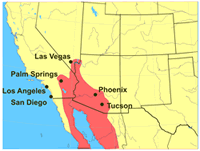Arizona Termites
Arizona has a remarkably rich termite fauna. At least 20 species are known from the state with the greatest diversity in the low elevation deserts and scrublands. Most of these are of little or no economic consequence.
- Sonoran Subterranean Termite, Heterotermes aureus

This is the major economic termite pest in Arizona. It is found in low desert areas of Arizona and California, extending into Mexico. It is native to Arizona and adapted to desert conditions. It even occurs in dunes and other areas with little vegetation. Nonetheless, it has adapted well to urban settings and can do major structural damage. It is a subterranean termite, which is to say that the primary nest (or nests) are typically underground. Workers excavate tunnels in the soil to locate sources of wood on which they feed. In almost every case, the termites are coming into structures from the outside. Nests can be at a considerable distance from an infested structure. The network of tunnels from a single colony may span a distance of nearly 100 yards.

Photo by Dr. R.H. Scheffrahn, University of Florida
Shown are the different life stages of Heterotermes aureus. Alates, or swarmers, generally appear in August after the onset of summer rains. They are yellow to pale brown in color and generally fly in the early evenings. Workers (middle) are whitish and sightless. They are unable to tolerate low humidity, a major reason that they always remain within the tunnel system. Soldiers (below) comprise 5% or less of foraging groups. With their large heads and mandibles, they cannot feed on wood themselves and must be given food by workers. They help defend tunnels, primarily against ants.

Photo by T.H. Atkinson
Subterranean termites will bridge exposed gaps by making covered passageways or mud tubes. Shown to the right is a special case, commonly referred to as a "drop tube". The termites have come up through the walls and into the ceiling. From there a group broke through the drywall, realized that there was open air, and started making a sealed tube. In the case of a piece of wood on the ground, making a drop tube a few inches back to the soil makes a certain amount of sense. Making one 8 ft off the ground in someone's living room is just an example of behavior that makes no sense in the wrong context. No one ever claimed that termites were smart, just persistent.
- Drywood Termites
-

These hard, dry pellets are all that most people see of drywood termites. Unlike subterranean termites, drywood colonies actually live completely within a piece of wood, or joined pieces of wood (your wall studs and cieling joists, for instance.) These termites do not actually require access to moisture, deriving all of their water from their diet. The 2 commonest species in Arizona are Marginitermes hubbardi and Incisitermes minor. From a homeowner's perspective, either one is bad news. Drywood termites require totally different control methods than subterranean termites. The most effective treatment is tent fumigation.

Photo by M.K. Rust
Shown are life stages of the western drywood termite, Incisitermes minor.
- Surface Feeding Termites

Photo by T.H. Atkinson
Another commonly seen group of termites commonly seen are surface feeding termites. They are sometimes referred to as "desert termites", "desert subs", or "ag termites", none of which are really appropriate. The most common species of this group in Arizona is Gnathamitermes perplexus. In general these termites should not be considered economic pests and are certainly not structural pests. They are most commonly seen in areas that do not receive irrigation.

Photo by T.H. Atkinson
The termites themselves are seldom seen, but their workings are well known. They build mud tunnels over dead grasses or weeds, often leaving only a mass of mud sheathing behind. These sheets of mud are also seen on trunks of palm trees, yuccas, and other trees.

Photo by T.H. Atkinson
On exposed wood they completely cover the area where feeding occurs with a continuous sheet of mud which usually falls off after a day or so. They only feed on the weathered, splintered surface, giving the appearance that the wood has been sandblasted over rounded areas. Apparently they are unable or indisposed to penetrate wood. They are particularly fond of paper and corrugated cardboard. On very rare occasions I have seen these termites inside structures feeding on papers or cardboard while ignoring the wood.
